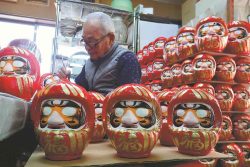Great Hanshin Earthquake Victims Remembered 29 Years on; Prayers also Offered for Noto Peninsula Earthquake Victims

Firelit lanterns were arranged to form the numerals “1.17” and the word “tomoni,” which means “together,” at Kobe East Park in Kobe at 5:46 a.m. Wednesday.
14:26 JST, January 17, 2024
KOBE — Memorials dedicated to the 6,434 victims of the Great Hanshin Earthquake took place in Kobe and other affected areas on Wednesday, 29 years to the day the disaster struck.
Participants mourning the victims of the massive 1995 earthquake also offered prayers for Noto Peninsula Earthquake victims, where more than 230 people have lost their lives and about 16,000 have been forced to take shelter.
At Kobe East Park in Chuo Ward, Kobe, an action committee comprising of a nonprofit organization and others held the memorial ceremony “1.17 no tsudoi” (A gathering for Jan. 17), which was attended by about 6,000 people as of 7 a.m. on Wednesday.
Firelit lanterns were arranged to form the numerals “1.17” and the word “tomoni,” which means “together,” to express sympathy for Noto Peninsula Earthquake victims. The participants observed a moment of silence at 5:46 a.m., the time the Great Hanshin Earthquake struck. Yuichi Suzuki, 34, of Suma Ward in Kobe, lost his mother Tomiyo, then 44, in the disaster. He expressed condolences to the victims of Hanshin and Noto Peninsula earthquakes as a representative of the bereaved.
A nonprofit organization solicited donations for Noto Peninsula Earthquake relief efforts at the Kobe East Park. A cloth was also set up in the park, on which visitors wrote messages to people in affected areas. Messages included, “We are supporting you from Kobe,” and “You will overcome this.” Donations and messages will be delivered together with relief supplies to quake-stricken areas.
People at the park are to observe a moment of silence at 4:10 p.m., the time the Jan. 1 Noto Peninsula Earthquake occurred.
The 1995 Great Hanshin Earthquake and the Noto Peninsula Earthquake have much in common: both earthquakes had shallow focuses with magnitudes exceeding 7, and their strong jolt, with a maximum intensity of 7 on the Japanese seismic intensity scale, caused many low quake-resistant buildings to collapse. Both also occurred in January, and many were forced to live in evacuation centers in the bitter cold. Shortages of food, toilets, blankets and other supplies were a serious problem at evacuation centers immediately after the earthquakes.
Following the Great Hanshin Earthquake, 921 people died from “disaster-related deaths” caused by stress of living in evacuation centers or worsening of chronic illnesses. The number of disaster-related deaths is also increasing in the Noto Peninsula.
Related Tags
"Society" POPULAR ARTICLE
-

M4.9 Earthquake Hits Tokyo, Neighboring Prefectures
-

Israeli Tourists Refused Accommodation at Hotel in Japan’s Nagano Pref., Prompting Protest by Israeli Embassy and Probe by Prefecture
-

M7.5 Earthquake Hits Northern Japan; Tsunami Waves Observed in Hokkaido, Aomori and Iwate Prefectures
-

Tsukiji Market Urges Tourists to Avoid Visiting in Year-End
-

High School in Kyoto Says Students Shoplifted during Recent School Trip to Bali, Indonesia
JN ACCESS RANKING
-

Tokyo Economic Security Forum to Hold Inaugural Meeting Amid Tense Global Environment
-

Keidanren Chairman Yoshinobu Tsutsui Visits Kashiwazaki-Kariwa Nuclear Power Plant; Inspects New Emergency Safety System
-

Imports of Rare Earths from China Facing Delays, May Be Caused by Deterioration of Japan-China Relations
-

University of Tokyo Professor Discusses Japanese Economic Security in Interview Ahead of Forum
-

Japan Pulls out of Vietnam Nuclear Project, Complicating Hanoi’s Power Plans

























